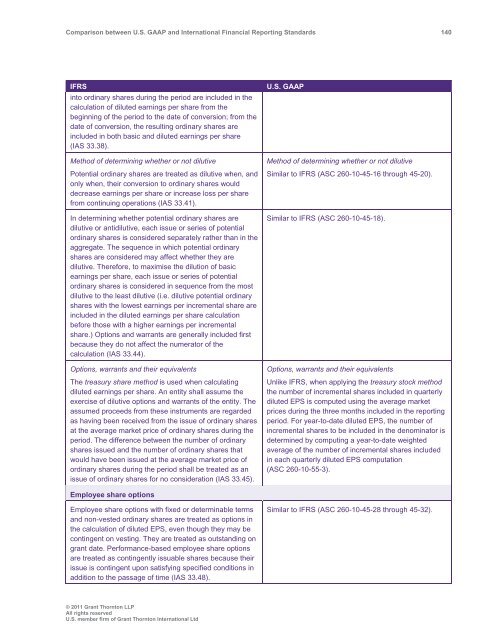Comparison between U.S. GAAP and International ... - Grant Thornton
Comparison between U.S. GAAP and International ... - Grant Thornton
Comparison between U.S. GAAP and International ... - Grant Thornton
You also want an ePaper? Increase the reach of your titles
YUMPU automatically turns print PDFs into web optimized ePapers that Google loves.
<strong>Comparison</strong> <strong>between</strong> U.S. <strong>GAAP</strong> <strong>and</strong> <strong>International</strong> Financial Reporting St<strong>and</strong>ards 140<br />
IFRS<br />
into ordinary shares during the period are included in the<br />
calculation of diluted earnings per share from the<br />
beginning of the period to the date of conversion; from the<br />
date of conversion, the resulting ordinary shares are<br />
included in both basic <strong>and</strong> diluted earnings per share<br />
(IAS 33.38).<br />
Method of determining whether or not dilutive<br />
Potential ordinary shares are treated as dilutive when, <strong>and</strong><br />
only when, their conversion to ordinary shares would<br />
decrease earnings per share or increase loss per share<br />
from continuing operations (IAS 33.41).<br />
In determining whether potential ordinary shares are<br />
dilutive or antidilutive, each issue or series of potential<br />
ordinary shares is considered separately rather than in the<br />
aggregate. The sequence in which potential ordinary<br />
shares are considered may affect whether they are<br />
dilutive. Therefore, to maximise the dilution of basic<br />
earnings per share, each issue or series of potential<br />
ordinary shares is considered in sequence from the most<br />
dilutive to the least dilutive (i.e. dilutive potential ordinary<br />
shares with the lowest earnings per incremental share are<br />
included in the diluted earnings per share calculation<br />
before those with a higher earnings per incremental<br />
share.) Options <strong>and</strong> warrants are generally included first<br />
because they do not affect the numerator of the<br />
calculation (IAS 33.44).<br />
Options, warrants <strong>and</strong> their equivalents<br />
The treasury share method is used when calculating<br />
diluted earnings per share. An entity shall assume the<br />
exercise of dilutive options <strong>and</strong> warrants of the entity. The<br />
assumed proceeds from these instruments are regarded<br />
as having been received from the issue of ordinary shares<br />
at the average market price of ordinary shares during the<br />
period. The difference <strong>between</strong> the number of ordinary<br />
shares issued <strong>and</strong> the number of ordinary shares that<br />
would have been issued at the average market price of<br />
ordinary shares during the period shall be treated as an<br />
issue of ordinary shares for no consideration (IAS 33.45).<br />
U.S. <strong>GAAP</strong><br />
Method of determining whether or not dilutive<br />
Similar to IFRS (ASC 260-10-45-16 through 45-20).<br />
Similar to IFRS (ASC 260-10-45-18).<br />
Options, warrants <strong>and</strong> their equivalents<br />
Unlike IFRS, when applying the treasury stock method<br />
the number of incremental shares included in quarterly<br />
diluted EPS is computed using the average market<br />
prices during the three months included in the reporting<br />
period. For year-to-date diluted EPS, the number of<br />
incremental shares to be included in the denominator is<br />
determined by computing a year-to-date weighted<br />
average of the number of incremental shares included<br />
in each quarterly diluted EPS computation<br />
(ASC 260-10-55-3).<br />
Employee share options<br />
Employee share options with fixed or determinable terms<br />
<strong>and</strong> non-vested ordinary shares are treated as options in<br />
the calculation of diluted EPS, even though they may be<br />
contingent on vesting. They are treated as outst<strong>and</strong>ing on<br />
grant date. Performance-based employee share options<br />
are treated as contingently issuable shares because their<br />
issue is contingent upon satisfying specified conditions in<br />
addition to the passage of time (IAS 33.48).<br />
Similar to IFRS (ASC 260-10-45-28 through 45-32).<br />
© 2011 <strong>Grant</strong> <strong>Thornton</strong> LLP<br />
All rights reserved<br />
U.S. member firm of <strong>Grant</strong> <strong>Thornton</strong> <strong>International</strong> Ltd
















